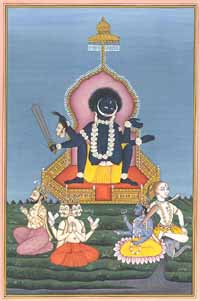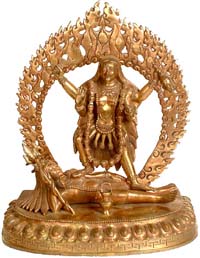
School Deering High School
Project Title Kali: Cross-Cultural (Mis)Understandings
|
|
5. Tantric tradition In the tantric tradition, especially of Bengal, Kali emerges as the greatest of all the deities, superior even to Brahma, Vishnu, and Shiva in her form as the essence of the Mahadevi, or Great Goddess (see image below). In this tradition, Kali comes to symbolize the power of shakti—that power of vitality that pervades reality, and acts in symbiotic tension with the “male” principle of Shiva.
As David Kinsley summarizes, “The [tantric] devotee appropriates the truths Kali reveals by adopting the attitudes of a child, whose essential nature towards its mother is that of acceptance, no matter how awful, how indifferent, how fearsome she is… In appropriating these truths, the devotee, like the tantric adept, is liberated from the fear these truths impose on people who deny or ignore them. Through devotion to Kali, the devotee becomes reconciled to death and achieves an acceptance of the way things are… Kali’s refusal to indulge her devotees in worldly pleasures enables her devotees to reflect on dimensions of themselves and of reality that go beyond bodily comfort and worldly security” (127). The mystical poetry of Ramprasad Sen celebrating Kali flows out of this tantric tradition. http://www.poetry-chaikhana.com/R/RamprasadSen/
|
This site was created by (Susan Barton Young) at the NEH Summer Institute "Cultures and Religions of the Himalayan Region," held at the College of the Holy Cross, Summer 2006

